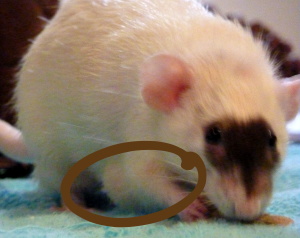
Most often, it’s quite easy to catch a pet rat tumor while it’s still small. If you handle your rat every day, you’ll be able to feel when a small mass first appears. Another way to find growths on your rat is to simply observe him or her closely. If you’re touching and interacting with your rats on a daily basis, you’ll easily become aware when a tumor develops.
Male and female rats can both get tumors. It’s more common for females to get mammary tumors, but males can get them as well. Spaying females can greatly reduce the occurrence of tumors. If you notice a swelling or lump anywhere on your rat, take him or her to the vet as soon as you can.
Pet Rat Tumors are Often Easy to Remove
The veterinarian performing the surgery sometimes doesn’t even need to cut into the body cavity. It’s better to remove a mass before it gets so large it impedes your rat’s mobility or impinges on an internal organ. Also, if the tumor is cancerous, it’s even more important to remove the tumor as soon as possible so wide margins* can be achieved which aid in preventing further the spread of the disease.
Some pet rat tumors grow quite rapidly. Your veterinarian will often do a fine needle aspirate to ascertain what types of cells are in the mass. Most often, tumors are benign. Even if they are cancerous, removing them—with wide margins—frequently prevents the cancer from spreading.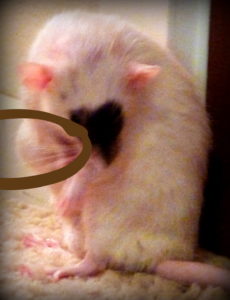
Removing pet rat tumors is usually a very safe procedure. I wouldn’t hesitate to have a tumor removed on any of my rats unless they were extremely old or had respiratory or heart problems. There are so many people who don’t realize just how easy it is to have the tumors removed.
You do not need to withhold food before surgery. If, when confirming your rat’s surgery, the veterinary hospital’s receptionist tells you to fast your rat, they may not have been trained properly. However, if the veterinarian tells you to withhold food, then you’ll know this vet isn’t knowledgeable. In this case, it’s best to find a different vet.
Dogs and cats (and humans) need to fast since they run the risk of vomiting during a procedure and can aspirate their vomit, resulting in respiratory problems. Rats, however, can’t vomit. The structures of their esophagus and stomach, and the way their muscles coordinate, don’t allow rats to vomit. Our rats do need to eat prior to surgery to maintain their blood sugar and to stay hydrated.
Post-surgery decisions
Once your pet rat’s tumor has been removed, your vet should send your rat home with pain medication such as buprenorphine or metacam. Your rat will either have sutures or the area could be closed with surgical glue. Recovery should be quick with your rat returning to normal energy and appetite within 1-2 days.
Your veterinarian may ask if you’d like the tumor to be sent to a lab for analysis. This is called a histopath. It does cost extra money and your veterinarian can help you decide whether learning the results will help in how you care for your rat. A histopath can 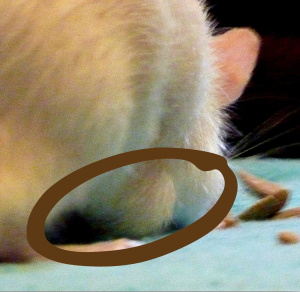 determine if it’s cancer, as well as how wide the margins are. As mentioned earlier, most tumors are benign (especially mammary tumors). So, if you’re on a tight budget, you may decide to decline a histopath. Also, in most cases a fine needle aspirate will have already been done.
determine if it’s cancer, as well as how wide the margins are. As mentioned earlier, most tumors are benign (especially mammary tumors). So, if you’re on a tight budget, you may decide to decline a histopath. Also, in most cases a fine needle aspirate will have already been done.
However, if your veterinarian recommends it, and you can afford it, a histopath allows you to know for sure what type of tumor was removed. If you do find out the tumor is cancerous—and you learn the margins weren’t very wide—you’ll know your rat may have a recurrence of the cancer. Having the histopath done also gives your veterinarian more information as to what medications and treatment plans will be most effective for your rat in the future.
*Wide Margins: The ideal surgery will include removal of a sizable portion of tissue around the perimeter of the mass in addition to the actual tumor. The tissue removed from areas adjacent to the tumor is the “margin.” Wide margins are helpful because they indicate all the entire tumor was removed. This is especially important if the tumor was cancerous. The detection of the size of the margin is part of the histopathology report.
Note: Male rats’ testicles have been mistaken as “tumors” by new rat owners. If you see two large “tumors” underneath your male rat’s tail, those are probably his testicles, not tumors.


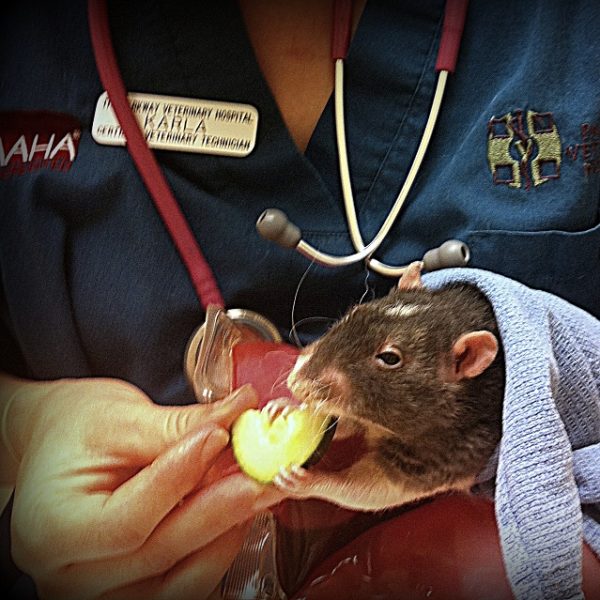
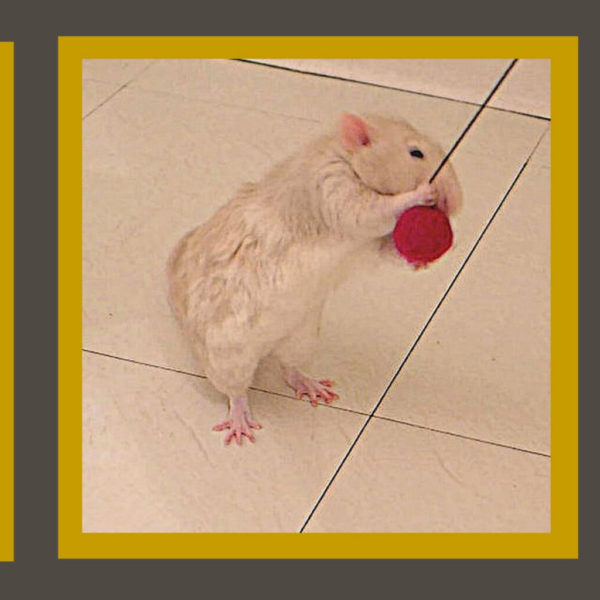



Hey there Jasmine!
I was wonder what clinic you went to to have the tumors removed? I also live in the Portland oregon area and saw a vet (exotic specialist) that quoted me for about 5k! I would greatly appreciate it and would rush her right away!
Hi Kimberly,
Nice to meet a fellow Portland, OR area rat person!
My vet is Dr. Melinda Surrency at Scales & Tails Exotic Pet Clinic. Dr. Surrency is an amazing pet rat veterinarian and she’s an amazing surgeon, too. She’s been my rats’ vet since around 2010. I even followed her to 2 different clinics before she opened her own exotic pet clinic (in around 2020?)
5k sounds super expensive for a surgery. I have never had to pay that much for any surgery for my rats. (And, unfortunately, my rats have had lots of surgeries!)
Let me know if you have any other questions anytime.
Best Wishes to You & Your Rats,
Jasmine | About Pet Rats
Typically how much would it cost to get a tumour removed or to spay rats?
Hi Bob,
Thanks for asking your question!
The cost of a spay or a tumor removal depends, of course, on the area in which you live. In case it’s helpful to know for cost comparison, I live near Portland, OR. My female rats were spayed at the end of last year. The cost per rat, including post-surgery pain medication to give at home, was around $300.
Removing a tumor costs less because less time under anesthesia is needed. If you only get the tumor removed without spaying, however, there’s a high likelihood of the tumor returning or a new one growing on a different part of of her body. This means there’s a high probability more than one tumor removal surgery would be needed. I’ve had 6 females spayed so far over around the past 15 years. Besides my current 2, my past 4 female rats who were spayed lived long, healthy, tumor-free lives.
I’m sure you’re aware you can call local vets in your area to see how much they would charge. The ideal way to find out would be to take your rat in for a wellness check—-which you would need to do before any surgery anyways. At the time of your rats’ exams, your vet can prepare estimates for you.
Let me know if you need any clarification or have any additional questions. I’m happy to help any time.
Best Wishes to You & Your Rats,
Jasmine | About Pet Rats
Hello,
I had to do the worst thing on Monday, February 20th… I had to put my pets down due to tumors… If I ever get pet rats again, is there a way I can prevent my rats from even developing tumors?
Hi Zee,
I am so sorry to hear you had to euthanize your rats due to tumors. My heart goes out to you. I sincerely feel for you and know how difficult and devastating it is to lose your precious rats.
Yes, if you get rats again in the future, there is a way for you to help prevent tumors. Spaying rats greatly reduces the likelihood of tumors and even helps to extend rats’ lives. I’ve gotten my last 6 female rats spayed (over the past 10 years) and none of them ever developed any tumors! The tricky part, though, is to find a veterinarian who’s knowledgeable about pet rats and who’s experienced with this type of surgery for rats. If you’re able to have female rats spayed, I highly recommend it.
Also, just thought I’d mention that if tumors are caught early on, the tumors are usually fairly easy to remove. You’ve probably already read about this in my post above on tumors, or were already aware of it.
My heart feels broken for you. Please know I’m thinking of you and sending you much compassion and support!
Jasmine | About Pet Rats
Greetings, our pet female rat (her name is “Enderman” after the Minecraft creature named by our 7 year old daughter) unfortunately she had a tumor, so we brought Enderman to a pet hospital where another one of our pet rats had a tumor successfully removed. They removed enderman’s tumor about 2 days ago, and since then she has not eaten or drank any water her breathing has looked labored and she is just not up and acting like herself at all and has us very worried. When we called the pet hospital, the only thing they can tell us what’s the doctor wasn’t there and maybe we should go somewhere else … the place they had suggested was absolutely out of our affordability. We are very worried about enderman, and we are wondering what honestly her chances are. Or if you have any hints, tips, or information for us.
Hi Dave and Jessy,
I’m so sorry to hear about your sweet rat, Enderman. I wish I’d seen your post right away….I apologize it’s taken me several days to respond.
After you wrote your message, were you able to take Enderman to a vet? I know you said one vet wasn’t affordable, but I’m hoping you found someone who was affordable. From what you’ve described, Enderman definitely needs to be seen by a veterinarian who’s knowledgeable about and experienced with pet rats.
Enderman’s symptoms of not eating or drinking and having labored breathing are very serious. I’m really worried she may not have survived.
Please feel free to email me an update. I’ll email you separately from my About Pet Rats email address to let you know I’ve received your message and can respond within a couple of hours if you do send me an update on how she’s doing.
I really feel for you and am hoping Enderman was able to overcome her health problems. I’m wondering if your vet who performed the surgery prescribed post-surgery pain medicine? And an antibiotic?
Sending positive wishes,
Jasmine
Both my female rats have tumors. they are 2 years old, and the tumors are huge…😢should I take them to the vet? my mom says that the vet would just put them down… I already lost one rat over the summer… I don’t want to lose 2 in the same period of time… but it looks really painful for them…
they are also albino if that makes any differance…
And they’re both developing two tumors in different spots on their bodies… Snowball has one under her tail, and under her armpit… Scarlet has one small one in between her shoulder blades and one gigantic one under her chin…. I don’t want to see them in pain…
Hi Zoeita,
I’m so sorry to hear your rats have tumors.
I do think it’s a very good idea to take them to a veterinarian who’s knowledgeable about and experienced with pet rats. In many cases the tumors can be successfully removed and rats can usually recover fairly quickly from the surgery. In general, though, it’s best to have a vet look at them as soon as the tumors start to develop, when they’re still small.
Tumors usually aren’t painful, but they are cumbersome and can be obstructive. Depending on where the tumors are growing, they can impede a rat’s ability to walk, swallow, etc.
It doesn’t make a difference that they’re albino rats. All rats are prone to developing tumors, especially unspayed females.
I’m thinking of you and your rats. I do hope you take them to a vet to get them evaluated and to see if surgery is a possibility.
If you have any other questions or need any clarification, don’t hesitate to ask.
Sending positive wishes to you and your girls,
Jasmine | About Pet Rats
PS: I tried to email you to let you know I’d responded and to give you the link to my response. However, the email address you supplied does not allow external email. Hopefully you’ll see what I wrote to you here.
My 2 1/2 year old albino male rat has developed a strange thing under his hip. It looks like a slice of pepperoni stuck on his fur–about 1.5″ round, flat, mottled red,doesn’t wash off.. I handled him about a week ago and did not notice anything. He is otherwise healthy, lively, interactive with his brother and me, eating well, curious as always. Any ideas?
Hi Dorothy,
I highly recommend you take your rat in to be examined by a veterinarian who’s knowledgeable about and experienced with pet rats. If you haven’t already done so, I’d take your rat in to be examined as soon as possible.
Any type of growth on a rat should be addressed right away. Sometimes a growth can increase in size quite quickly. Growths and masses are much easier to address before they become more advanced.
From your description, I’m not able to say what type of growth your rat has. You’re welcome to email me a photo….however, really, the best way to help your rat is to take him to a knowledgeable vet.
Thanks for asking your question. Don’t hesitate to let me know if you have any additional questions….I’m always happy to help.
Sending positive wishes to you and your rat.
Jasmine | About Pet Rats
Hey I recently found a small lump on my year and 9 month year old female rat Rouge. I found it on her rear end near her tail and I’m not sure how to treat it or when is the best time to take her in to the vet as she doesn’t do well with stranges and I don’t want to stress her out and possibly cause more damage. I lost her sister Scarlett about 2 months ago because if a tumor the grew almost over night and I am terrified to lose her too.
Hi Jasper,
It’s important to take your rat to the vet as soon as you detect a lump….or any other problem. Tumors can grow quickly. In most cases, the sooner they’re removed the better. Most of the time they’re easy to remove and rats usually recover quickly and easily from tumor removal surgeries. As I mentioned in my article above, spaying female rats definitely reduces the chances of tumors developing.
Besides taking care of the tumor as soon as possible, it’s important to find a veterinarian who’s knowledgeable about and experienced with pet rats. In case you don’t already have a great rat vet, I have a whole section on my website about this. One of the pages you may find helpful is Choosing a Veterinarian for Your Pet Rats.
Let me know if you have any other questions.
Best Wishes to You & Rouge,
Jasmine | About Pet Rats
Halothane before euthanasia is the MOST HUMANE
Hi Joanne,
Thank you for your comment. I am currently writing a page on euthanasia for pet rats. I’d be interested in hearing more about your experience with using halothane. I’ll email you to see if you’d like to provide further information.
Thanks again for commenting and sharing your recommendation. Having the most humane euthanasias performed for our rats is so important.
Jasmine | About Pet Rats
Hello there,
Our 2.5 year old had a tumor removed this summer. She had a slow recovery from the procedure and lost a lot of weight even with us feeding her hourly various protein/ veggie sources because she wasn’t able to feed herself.
2 months later, we noticed she had another apparent mammary tumor growing. We were afraid of the recovery process to have this one removed so shortly after the previous one. So we decided that this would be her natural process.
Currently her quality of life has been decreasing slowly, she only lays down on the couch with us and doesn’t want to run around anymore. Her tumor is not affecting her mobility at this point, but she is showing some signs of lethargy and lack of appetite. At what point do we decide that she has reached the point when euthanizing may be the only humane option for her?
We love her like a child, but we don’t want her to suffer because of us not making the choice when needed.
Hi Sara,
Thank you for asking your very important questions. My heart is heavy for you—-I truly know how hard the process is of not only watching one’s beloved rat decline. Then, on top of that to also figure out when it’s time to euthanize.
I hope you don’t mind that my response below is quite lengthy. If you need a cliff notes version, just let me know. I just thought it might be helpful to give you all of the details and information that I’ve learned over the past 30 years.
First of all, one thing that comes to mind after reading what you wrote: You say that the tumor is not affecting her mobility at this point but that she is showing signs of lethargy and lack of appetite. If the tumor isn’t affecting her mobility, it may not be the cause of her lethargy. Do you think she may have other health issues right now? Is she making any sounds while breathing? Does she have any porphyrin around her nose and/or eyes?
That’s just a thought for you to consider—-that it may not be the tumor that’s causing her current symptoms.
Your question about how to decide when she’s reached the point when “euthanizing may be the only humane option for her” is such a good one. I need to write an entire article about this but haven’t had time to do so yet. But I definitely want to share everything with you right now.
For me, the decision becomes clear when my rat is:
1) No longer interested in food
2) No longer enjoying life (not interacting with other rats or with humans, no longer grooming, sleeping almost all of the time)
3) My veterinarian says there’s no chance of my rat’s health improving (this one, in particular, is a clear indication it’s getting close if not time to euthanize)
If I don’t euthanize when the above three criteria are met, it means I’m prolonging my rat’s death which will likely be painful and slow.
From here, I absolutely must mention that not all veterinarians are skilled at performing rat euthanasias. It’s very important to know ahead of time what method your veterinarian will be using. I recommend you call your vet’s office early on—-before you’re getting so close to euthanizing that you can’t talk about it without getting choked up.
What follows is a draft of another blog post I haven’t yet finished writing. I just think this information is so important that I want to share it with you:
For my first rat euthanasia (in the early 1990’s) I had no idea how important it is to plan ahead and check on the process the vet uses before even having to make the decision to euthanize. The first time I had a rat euthanized, the doctor injected the euthasol directly into my rat’s heart without any sedation. My rat was screaming. It’s probably the worst thing I’ve ever witnessed. The doctor decided to give my rat “a break” and then started the process all over again. I will never, ever forget this terrible event and the trauma my poor rat experienced.
After my first pet rat was euthanized in this horrible manner, I started reading up and asking everyone I knew how to make the process humane and loving.
Please note that what I’ve written below applies more easily to non-COVID times. My current vet, however, does still allow humans to come inside the hospital if it’s for a euthanasia. If you don’t have a vet who allows you to come in with your rat you can either try to find a different vet or, again, make sure to talk through every step they go through in their process of euthanizing rats.
I now go to a vet whose first step when euthanizing is to place several drops of xylazine, a sedative, into my rat’s nostrils. If this doesn’t effectively slow down and sedate the rat, a sedative can be injected into the scruff of the rat’s neck. (It is also sometimes injected into a hind leg rather than the scruff of the neck.) The injection is very quick and, when it’s given, my rats barely notice receiving it. It usually takes 5-10 minutes before a rat will really relax from the sedative.
At this point, some vets will want to take your rat to the treatment area while you wait in an exam room. I, personally, like to make sure that I am with my rat for every single part of the process. If you want to be with your rat throughout the process, as I do, make sure you discuss this with your veterinarian ahead of time. Talk with your vet on the phone prior to your appointment to find out the process they use as well as to ask if you can be with your rat for every step of the process.
[For anyone reading this who has a young, healthy rat, a good time to learn about your veterinarian’s euthanasia process is during a wellness exam so it’s not such an emotional topic. It’s so much easier to discuss this when you don’t actually need to euthanize your rat anytime soon.]
Next, a gas sedative is used. Some vets place the rat in a plexiglass box that has a tube attached for the gas to enter the chamber. I prefer using a mask—-a little cone that goes over their face—since I’ve observed my rats get very scared being alone in a box with gas coming in. If they’ve been given enough of the injectable sedative prior to receiving the gas, they will be able to easily tolerate having a mask put on their face. (But I don’t find they tolerate as easily the plexiglass box method since they’re all alone, isolated from any human touch. It’s nice that while they’re wearing the mask, that you can still pet and reassure your rat while she’s receiving the gas. Then, after the gas anesthesia fully takes effect, the doctor injects the heart with the euthanasia solution, euthasol, which is a pink liquid.
The doctor should check VERY thoroughly to make sure the rat is completely anesthetized before injecting the heart with the euthasol—they can check to make sure a rat is fully anesthetized in many ways. One way is to gently pinch one of your rat’s feet to see if there’s any reaction. (If there’s no reaction, they’re fully sedated.)
Please note that there are some vets who will sedate a rat by injection without following it with gas anesthesia. I haven’t tried this method yet, but my current vet has assured me it can be done very effectively and peacefully. Even though I trust my vet, I still prefer to have the anesthetic used to create an extra layer of comfort and oblivion for my rat being euthanized. It may not be truly necessary, however.
After the euthasol is injected—which should be done while your rat is still receiving the gas anesthetic—the mask can be removed from your rat’s face. Within a minute or two, your veterinarian will listen to your rat’s heart using a stethoscope to confirm there is no longer a heartbeat.
It’s the saddest thing in the world to euthanize one of our rats, but it’s also one of the most humane things we can do to help our best friends die a peaceful death.
I almost forgot to include that some believe the last sense a rat (or anyone about to die) has is their sense of hearing. For that reason, I continually am talking softly and lovingly to my rat throughout the entire process. I do this up until the doctor checks her heart with a stethoscope at the very end.
I hope you find the above information helpful. If you have any further questions, don’t hesitate to let me know. I’m happy to help any time.
I’m sending positive wishes for your sweet rat. May she have the “softest landing” possible.
Jasmine
Hi there,
Our rat developed a tumor so we brought him to the vet. She said that because he’s already quite old that surgery would be risky on his already fragile system.
So, we’ve been caring for him as best we can as the tumor has grown. It’s at a size now where it’s getting in the way of his arms, making it difficult for him to hold his food.
We’re considering feeding him through a food syringe. He doesn’t seem to be in pain and is in generally good spirits.
Do you think that is a good idea and if so, do you have a liquid food recipe you recommend?
Hi Clayton,
I’m so sorry to hear your rat isn’t a good candidate for surgery to remove his tumor. That is really tough. However, it’s great to hear he doesn’t seem to be in pain and is in generally good spirits. It sounds like you’re doing a wonderful job of looking after him, too.
The best way to feed him a liquid diet would be to soak his regular food in water. Are you already feeding him a good commercial lab block or kibble? (Examples are Oxbow Essentials Regal Rat Adult Rat Food or Envigo. If you’re not already feeding him a quality commercial rat diet, you can find more info on my page on pet rat commercial diets.)
Another thing you can do is to make up a mix of canned Hill’s a/d, baby rice cereal, organic fruit baby food and water. The Hill’s a/d is only available from a veterinarian’s office. It would be great to ask your vet as well what she would recommend you feed him and see if she likes the idea of feeding him Hill’s a/d mixed with other ingredients—then you can get the a/d from your vet.
Is he able to put his head into a little dish instead of your needing to feed him with a syringe? Eating out of a dish would give him more independence which he might like.
If he does start eating a more liquid diet, be sure and check his teeth regularly. Rats’ teeth can grow quite rapidly if they’re not gnawing on things to wear them down. They can even grow right up into the roof of their mouth. You may want to have your vet take a look at his teeth. It is usually fairly easy for a vet to trim a rat’s teeth. If his teeth do start to grow and need trimming you should have them checked to see if they need retrimming on a monthly basis.
Other things to consider are you’ll want to make sure there aren’t areas in his cage from which he can fall. If he’s not getting around as well, make sure there aren’t any ledges or different levels that are up so high that a fall could cause an injury.
Finally, you’ll want to make sure he’s still able to groom himself. If he’s not, you can give him a daily “sponge bath” with a cotton ball. It’s especially important to keep his anal area and penis clean.
Thanks for asking your great question. I hope my response gives you some ideas of what you can do for your rat. Don’t hesitate to ask if you have any additional questions.
Sending best wishes to you and your rat,
Jasmine | About Pet Rats